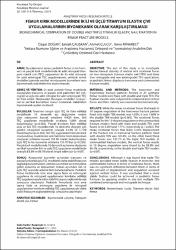| dc.contributor.author | Doğan, Ramazan Özgür | |
| dc.contributor.author | Çalışkan, Emrah | |
| dc.contributor.author | Çulcu, Ahmet | |
| dc.contributor.author | Minareci, Emre | |
| dc.date.accessioned | 2021-05-05T22:17:16Z | |
| dc.date.available | 2021-05-05T22:17:16Z | |
| dc.date.issued | 2019 | |
| dc.identifier.issn | 1302-4612 | |
| dc.identifier.issn | 2149-7869 | |
| dc.identifier.uri | https://app.trdizin.gov.tr/makale/TXpnek5qSTRPQT09 | |
| dc.identifier.uri | https://hdl.handle.net/20.500.12933/693 | |
| dc.description.abstract | AMAÇ: Bu çalışmanın amacı, pediatrik femur cisim transvers ve parçalı kırık modellerinde iki adet retrograt titanyum elastik çivi (TEÇ) uygulaması ile iki adet retrograt bir adet anterograt TEÇ uygulamasının, sentetik kemik modeller üzerinde vertikal ve rotasyonel kuvvetlere karşı biyomekanik stabilitelerinin araştırılmasıdır. GEREÇ VE YÖNTEM: 24 adet sentetik femur modelinde oluşturulan transvers ve parçalı kırık paternleri ikili (retrograt) ve üçlü (iki adet retrograt bir adet anterograt) TEÇ ile fiske edildi. Oluşturulan fiksasyon modelleri rotasyonel ve vertikal kuvvetlere maruz bırakılarak stabiliteleri biyomekanik açıdan incelendi. BULGULAR: Transvers kırığın üçlü TEÇ ile fiske edildiği modellerde 10 derecelik açı değişimine neden olan rotasyonel kuvvet ortalama 4.92N iken, ikili TEÇ uygulanan modellerde ortalama 1.86N olarak bulunmuştur (p=0.002). Parçalı kırıkların fiske edildiği üçlü ve ikili TEÇ modellerinde 10 derecelik değişim için gerekli rotasyonel kuvvetler sırasıyla 3.43N ve 1.77N bulunmuştur (p=0.002). İkili TEÇ uygulanan transvers kırık oluşturulmuş modellerde kırık hattında 5mm deplasman oluşturan ortalama kuvvet 103.6N olarak bulunmuşken, üçlü TEÇ’te bu kuvvetler ortalama 135.7N’dur (p=0.238). Parçalı kırık modellerinde 10 derecelik açılanma oluşturan vertikal kuvvetler ikili ve üçlü TEÇ uygulanan modellerde sırasıyla 83.8N ve 86.1N olarak tespit edilmiştir (p=0.87). SONUÇ: Rotasyonel kuvvetler açısından transvers ve parçalı kırıklarda üçlü TEÇ modelinin daha stabil fiksasyon sağladığı bulunmuşken, vertikal kuvvetlere karşı meydana gelen açılanma ve deplasman miktarı açısından ikili ve üçlü TEÇ arasında anlamlı fark bulunamamıştır. Pediatrik femur kırıklarında ince ama sayıca fazla ve anterograt uygulama ile retrograd uygulamanın kombine edildiği TEÇ uygulanmasıyla daha stabil fiksasyon sağlanabileceği sonucuna ulaşılmıştır. Pediatrik femurlarda ince ama sayıca fazla ve anterograt uygulama ile retrograd uygulamanın kombine edildiği TEÇ uygulanmasıyla daha stabil fiksasyon sağlanabileceği sonucuna ulaşılmıştır. | en_US |
| dc.description.abstract | OBJECTIVE: The aim of this study is to investigate biomechanical stability of vertical and rotational forces on two retrograde titanium elastic nail (TEN) and three (two retrograde and one anterograde) TEN applications in pediatric femur diaphysis transverse and communited fracture models. MATERIAL AND METHODS: The transverse and fragmented fracture patterns formed in 24 synthetic femur models were fixed with double and triple TEN. The fixation models were subjected to rotational and vertical forces and their stability was examined biomechanically. RESULTS: While the mean rotational forces that leads to 10 degree angulation of the transverse fracture pattern fixed with triple TEN models was 4.92N, it was 1.86N in the double TEN models (p=0.002). The rotational forces required for the 10-degree angulation in the communited fracture models fixed with triple and double TEN were found to be 3.43N and 1.77N, respectively (p = 0.002). The mean rotational forces that leads 5-mm displacement at the fracture site in transverse fracture patterns fixed with double TEN was 103.6N, on the other hand these mean forces was 135.7N in the triple TEN models. In communited fracture models, the vertical forces results in 10 degree angulation were found to be 83.8N and 86.1N, respectively, in the double and triple TEN models (p=0.87). CONCLUSIONS: Although it was found that triple TEN models provided more stable fixation in transvers and communited fracture in terms of rotational forces, there was no significant difference between them in terms of the amount of displacement and angulation occurred against vertical forces. It was concluded that a more stable fixation could be achieved in pediatric femur fractures by applying smaller in size but multiple TEN combined anterograde and retrograde technique. | en_US |
| dc.language.iso | tur | en_US |
| dc.rights | info:eu-repo/semantics/openAccess | en_US |
| dc.subject | [No Keywords] | en_US |
| dc.title | FEMUR KIRIK MODELLERİNDE İKİLİ VE ÜÇLÜ TİTANYUM ELASTİK ÇİVİ UYGULAMALARININ BİYOMEKANİK OLARAK KARŞILAŞTIRILMASI | en_US |
| dc.title.alternative | BIOMECHANICAL COMPARISON OF DOUBLE AND TRIPLE TITANIUM ELASTIC NAIL FIXATION IN FEMUR FRACTURE MODELS | en_US |
| dc.type | article | en_US |
| dc.department | AFSÜ | en_US |
| dc.identifier.volume | 20 | en_US |
| dc.identifier.issue | 3 | en_US |
| dc.identifier.startpage | 109 | en_US |
| dc.identifier.endpage | 114 | en_US |
| dc.relation.journal | Kocatepe Tıp Dergisi | en_US |
| dc.relation.publicationcategory | Makale - Ulusal Hakemli Dergi - Başka Kurum Yazarı | en_US |
















